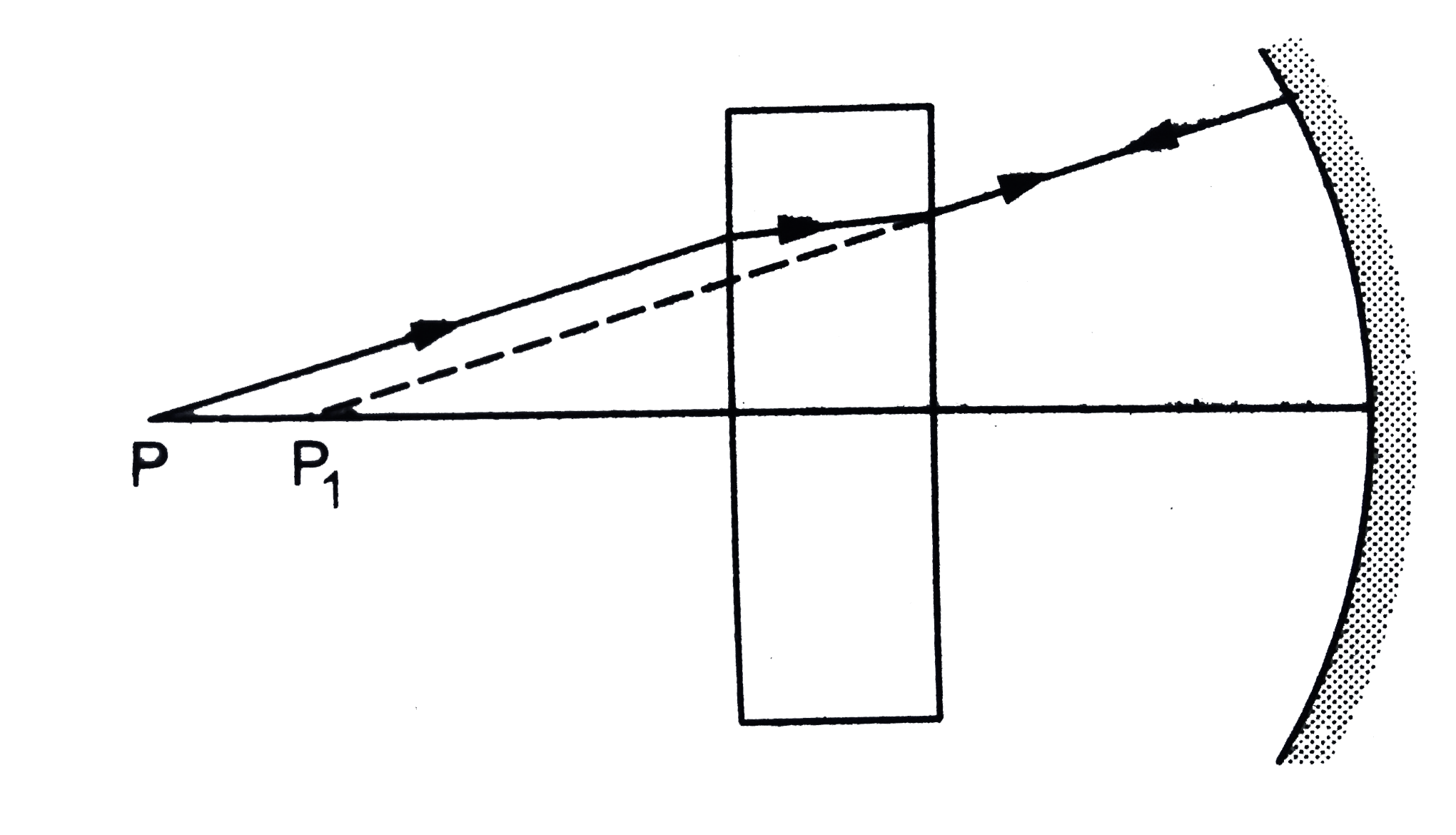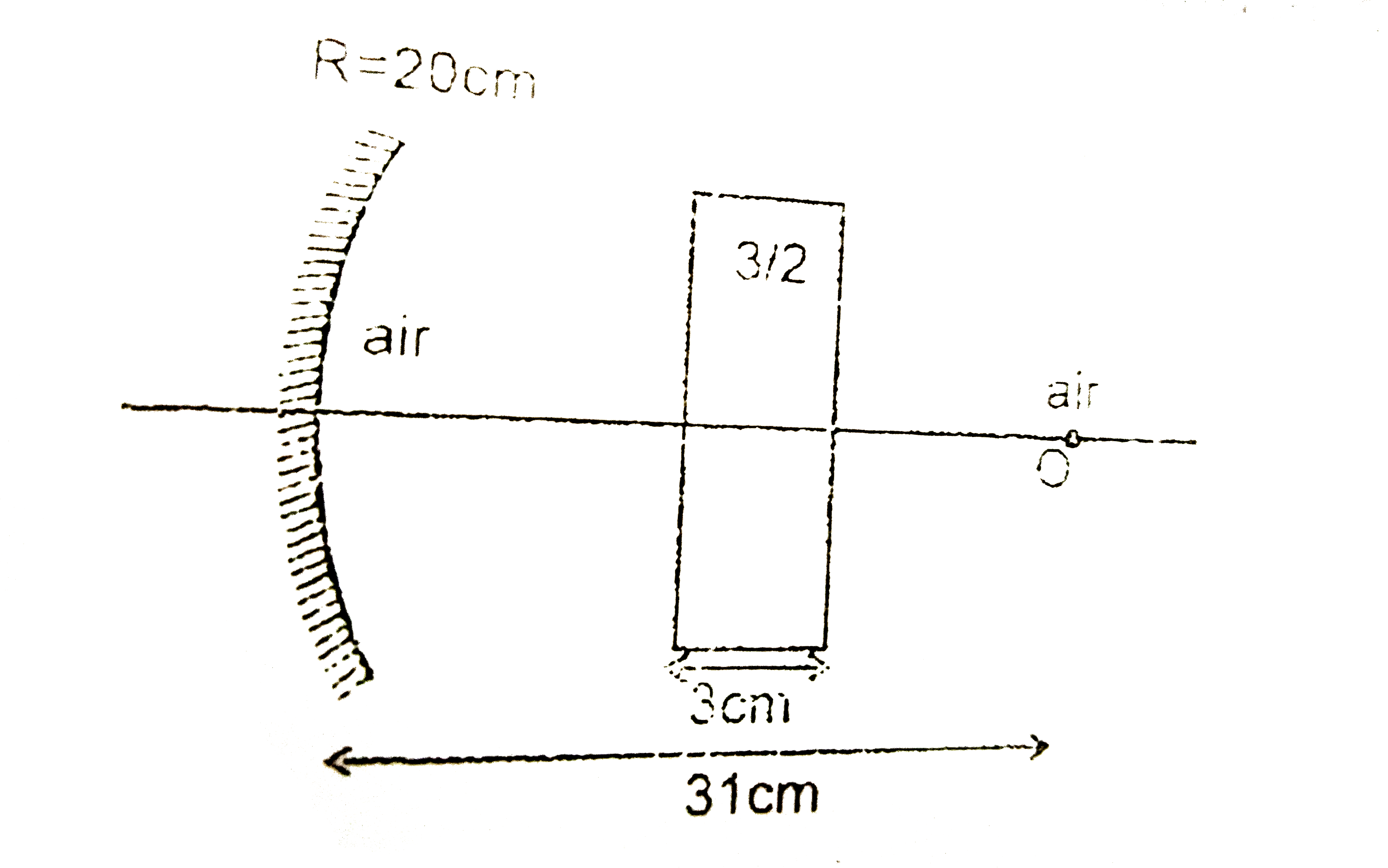An object is placed 21 cm in front of a concave mirror of radius of curvature 10cm. A glass slabe of thickness 3cm and refractive index 1.5 is then placed close to the irror in the space between the object and the mirror. The distance of the near surface of the slabe from the mirror is 1cm. The final image from the mirror will be formed at
To solve the problem step by step, we will follow the sequence of events as described in the video transcript.
Step 1: Identify the given values
- Object distance (u) = -21 cm (the negative sign indicates that the object is in front of the mirror)
- Radius of curvature (R) = -10 cm (for a concave mirror, R is negative)
- Thickness of the glass slab (t) = 3 cm
- Refractive index of the glass slab (μ) = 1.5
- Distance of the near surface of the slab from the mirror = 1 cm
Step 2: Calculate the focal length (f) of the concave mirror
The focal length (f) of a concave mirror is given by the formula:
f=−R2
Substituting the value of R:
f=−−10cm2=−5cm
Step 3: Calculate the apparent shift due to the glass slab
The apparent shift (Δ) caused by the glass slab can be calculated using the formula:
Δ=t(1−1μ)
Substituting the values:
Δ=3cm(1−11.5)
Δ=3cm(1−0.6667)
Δ=3cm×0.3333=1cm
Step 4: Calculate the new object distance (u')
The new object distance (u') is the original object distance minus the shift:
u′=u−Δ
Substituting the values:
u′=−21cm−1cm=−20cm
Step 5: Use the mirror formula to find the image distance (v)
The mirror formula is given by:
1f=1v+1u′
Rearranging gives:
1v=1f−1u′
Substituting the known values:
1v=1−5−1−20
Finding a common denominator:
1v=−420+120=−320
Thus,
v=−203cm
Step 6: Interpret the result
The negative sign indicates that the image is formed on the same side as the object, which is typical for a virtual image in a concave mirror.
Final Answer
The final image from the mirror will be formed at approximately −6.67cm from the mirror.
---
- Object distance (u) = -21 cm (the negative sign indicates that the object is in front of the mirror)
- Radius of curvature (R) = -10 cm (for a concave mirror, R is negative)
- Thickness of the glass slab (t) = 3 cm
- Refractive index of the glass slab (μ) = 1.5
- Distance of the near surface of the slab from the mirror = 1 cm
The focal length (f) of a concave mirror is given by the formula:
f=−R2
Substituting the value of R:
f=−−10cm2=−5cm
The apparent shift (Δ) caused by the glass slab can be calculated using the formula:
Δ=t(1−1μ)
Substituting the values:
Δ=3cm(1−11.5)
Δ=3cm(1−0.6667)
Δ=3cm×0.3333=1cm
The new object distance (u') is the original object distance minus the shift:
u′=u−Δ
Substituting the values:
u′=−21cm−1cm=−20cm
The mirror formula is given by:
1f=1v+1u′
Rearranging gives:
1v=1f−1u′
Substituting the known values:
1v=1−5−1−20
Finding a common denominator:
1v=−420+120=−320
Thus,
v=−203cm
The negative sign indicates that the image is formed on the same side as the object, which is typical for a virtual image in a concave mirror.
The final image from the mirror will be formed at approximately −6.67cm from the mirror.
Topper's Solved these Questions
- BOOK - AAKASH INSTITUTE ENGLISHCHAPTER - RAY OPTICS AND OPTICAL INSTRUMENTSEXERCISE - EXERCISE45videos
RAY OPTICS AND OPTICAL INSTRUMENTS
- BOOK - AAKASH INSTITUTE ENGLISHCHAPTER - RAY OPTICS AND OPTICAL INSTRUMENTSEXERCISE - ASSIGNMENT (SECTION - A)39videos
RAY OPTICS AND OPTICAL INSTRUMENTS
- BOOK - AAKASH INSTITUTE ENGLISHCHAPTER - RAY OPTICS AND OPTICAL INSTRUMENTSEXERCISE - Assignment (Section - J) Aakash Challengers Questions7videos
RAY OPTICS AND OPTICAL INSTRUMENTS
- BOOK - AAKASH INSTITUTE ENGLISHCHAPTER - PHYSICAL WORLDEXERCISE - ASSIGNMENT (Section-B)4videos
PHYSICAL WORLD
- BOOK - AAKASH INSTITUTE ENGLISHCHAPTER - SEMICONDUCTOR ELECTRONICS (MATERIAL, DEVICES AND SIMPLE CIRUITS )EXERCISE - Assignment SECTION - D (Assertion & reason type Question)10videos
SEMICONDUCTOR ELECTRONICS (MATERIAL, DEVICES AND SIMPLE CIRUITS )
Similar Questions
An object is placed at 21 cm in front of a concave mirror of radius of a curvature 10 cm. A glass slab of thickness 3 cm and u 15 is then placed close to the mirror in the space between the object and the mirror. The position of final image formed is
View SolutionAn object is placed 21 cm in fron of a concave mirror of radius of curvature 20 cm.A glass slab of thicknes 3 cm and refractive index 1.5 is palced close to the mirror in the space between the object and the mirror. Find the position of the final image fromed. The distance of the nearer surface of the slab from the mirror is 10 cm.
 View Solution
View SolutionA point object is placed 33cm from a convex mirror of curvature radius =40cm A glass plate of thickness 6cm and refractive index 2.0 placed between the object and mirror,close to the mirror,find the distance of final image form the object?
View SolutionAn object 2.5 cm high is placed at a distance of 10 cm from a concave mirror of radius of curvature 30 cm The size of the image is
View SolutionAn object is placed at 4 cm distance in front of a concave mirror of radius of curvature 24 cm. Find the position of image. Is the image magnified?
View SolutionAn object is placed 40 cm from a concave mirror of focal length 20 cm. The image formed is
View SolutionA linear object of heigth 10 cm is kept in front of concave mirror of radius of curvature 15 cm, at distance of 10 cm. The image formed is
View SolutionAn object of size 7.5 cm is placed in front of a convex mirror of radius of curvature 25 cm at a distance of 40 cm. The size of the image should be
View SolutionA point object is placed on principal axis of a concave mirror of radius of curvature 20cm at a distance 31cm from poll of the mirror. A glass slab of thikness 3cm and refractive index 1.5 is placed between object and mirror as shown in the figure. Find the distance (in cm) of final image formed by the system from the mirror.
 View Solution
View SolutionAn object 5 cm tall is placed 1 m from a concave spherical mirror which has a radius of curvature of 20 cm. The size of the image is
View Solution

